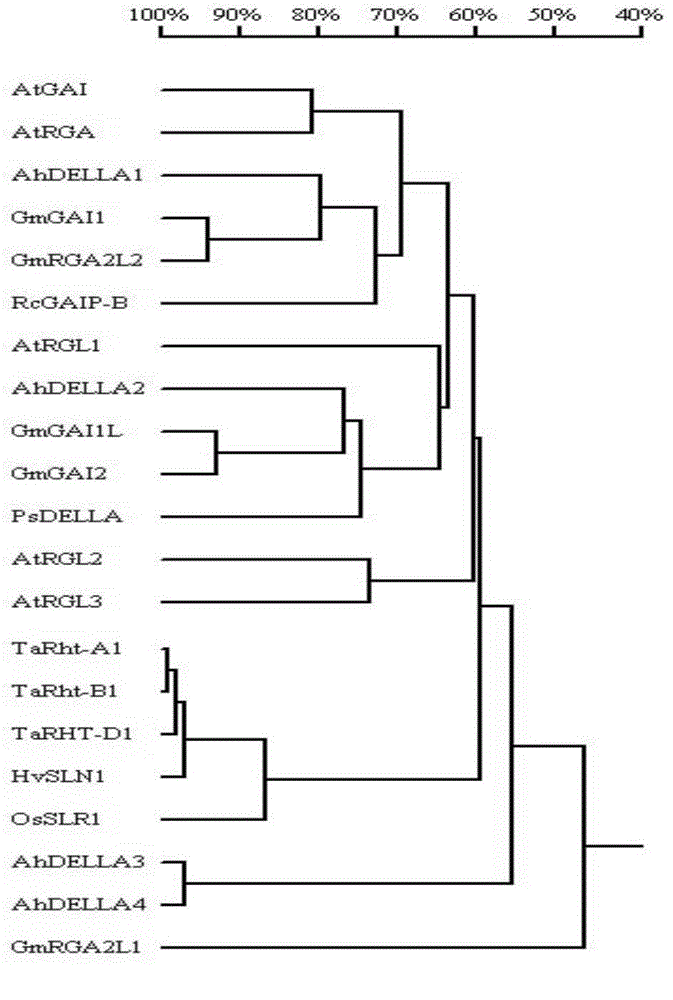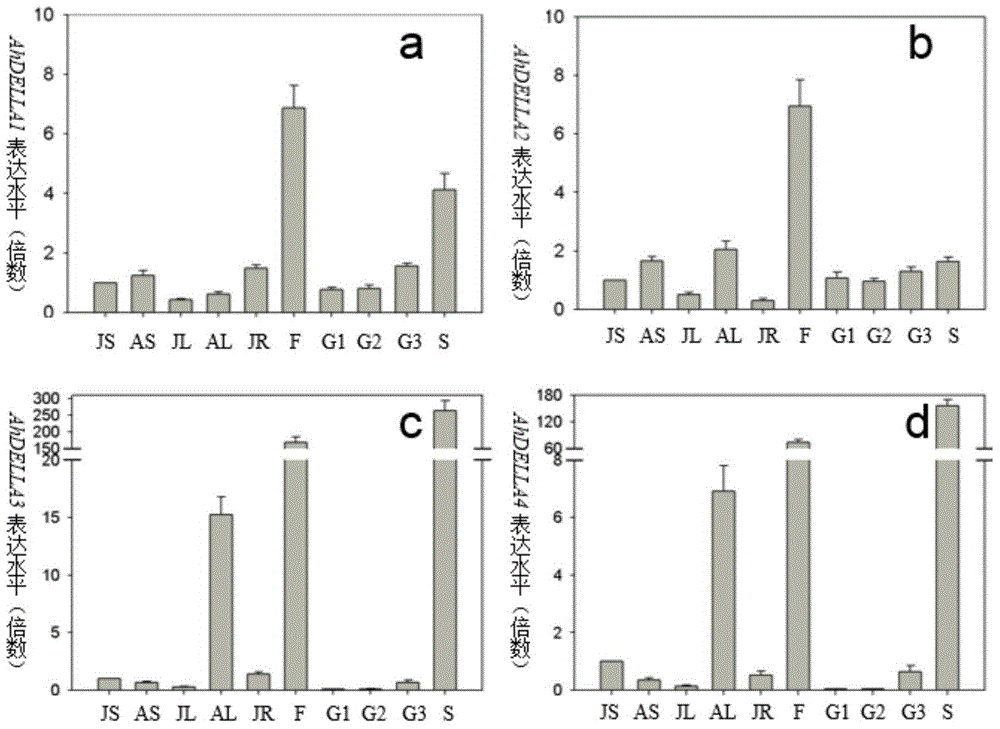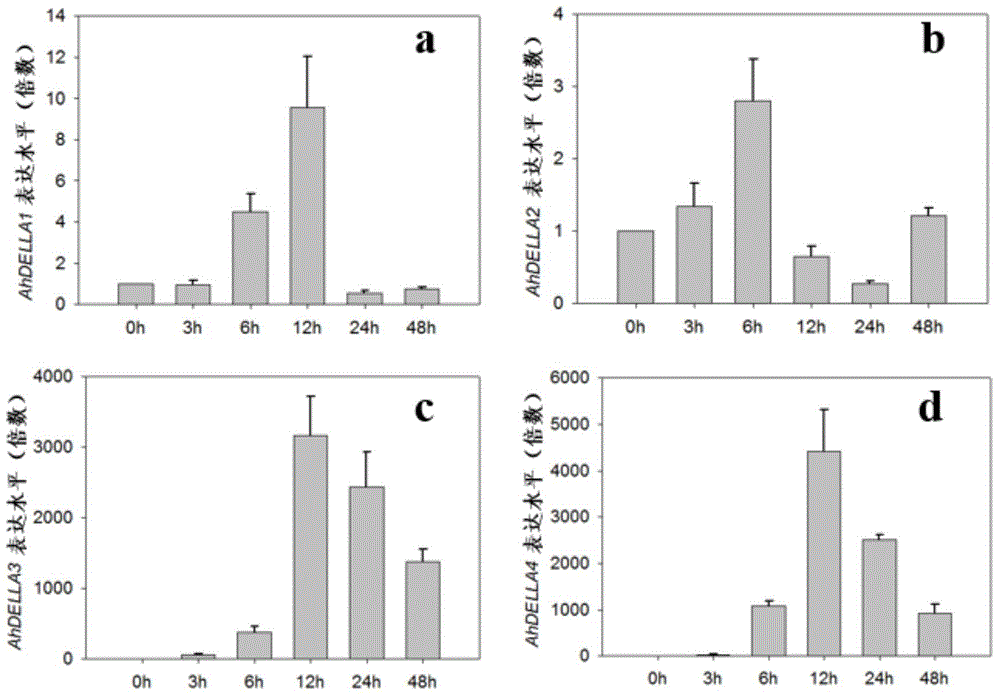DELLA gene families of peanut as well as encoding genes and applications of DELLA gene families
A technique for peanuts and encoding, which is applied in the field of molecular biology and can solve problems such as the backwardness of peanut molecular biology research
- Summary
- Abstract
- Description
- Claims
- Application Information
AI Technical Summary
Problems solved by technology
Method used
Image
Examples
Embodiment 1
[0049] Example 1: Cloning of Peanut AhDELLA Gene Family Gene and Full-length Gibberellin Receptor AhGID1 Gene
[0050] Using the nucleotide sequence of soybean DELLA protein with high homology to peanut, the homologous comparison was used to search the early transcriptome database of peanut needle and pod development, and a total of four groups of Unigenes related to DELLA were found, and each group came from one gene. Among them, the Unigene from AhDELLA2 contains a start codon and is deleted at the 3' end; the Unigenes from AhDELLA1, AhDELLA3, and AhDELLA4 are all deleted at the 5' end and 3' end. The same method was used to search the transcriptome database in the early development of peanut needles and pods, and the full-length sequence of the AhGID1 gene was obtained by splicing short fragments.
[0051] Nested PCR was amplified by 5'RACE and 3'RACE, and the full-length open reading frames of the DELLA gene family AhDELLA1, AhDELLA2, AhDELLA3 and AhDELLA44 genes were fina...
Embodiment 2
[0155] Example 2: Homology analysis of peanut DELLA protein
[0156] The amino acid sequences of the peanut DELLA protein gene family are shown in SEQ ID NO.1, SEQ ID NO.3, SEQ ID NO.5, and SEQ ID NO.7.
[0157] Search the DELLA protein of the following species on the NCBI website: Arabidopsis thaliana, wheat, soybean, barley, rice, castor, pea, and use the DNAMAN software to compare the amino acid sequence homology ( figure 1 ). The results show that AhDELLA1 and AhDELLA2 are divided into two branches, and the amino acid sequence identities with DELLA proteins of other species are about 70% and 65%, respectively; while the homology between AhDELLA3 and AhDELLA4 is very high, reaching 97%, but Homology to other species is low. It shows that AhDELLA3 and AhDELLA4 may have similar functions, but unlike AhDELLA1 and AhDELLA2, AhDELLA3 and AhDELLA4 may have unique functions in peanut.
Embodiment 3
[0158] Example 3: Analysis of the expression pattern of the DELLA gene family in different tissues of peanut
[0159] 3.1 Extraction of RNA from plants:
[0160] With the 1.1 step in the embodiment 1, extract respectively peanut juvenile stem (15 days, JS), adult stem (40 days, AS), juvenile leaf (15 days, JL), adult leaf (40 days, AL), root ( JR), flowers (F), fruit needles not buried in soil (G0), fruit needles buried in soil for 3 days (G3), fruit needles buried in soil for 9 days (G9), immature seeds (S) and other tissues in different periods. RNA.
[0161] 3.2 Acquisition of cDNA from different tissues of peanut:
[0162] Same as 1.11 step (1) in Example 1.
[0163] 3.3 Using fluorescent quantitative PCR technology to analyze the expression pattern of DELLA gene family genes:
[0164] With AhActin as the system internal reference, the primer sequence is:
[0165] AhActinqF:5'-GTCATCGTCATCCTCTTCTC-3'(SEQ ID NO.35);
[0166] AhActinqR: 5'-CATTCCTGTTCCATTGTCAC-3' (SEQ ...
PUM
 Login to View More
Login to View More Abstract
Description
Claims
Application Information
 Login to View More
Login to View More - Generate Ideas
- Intellectual Property
- Life Sciences
- Materials
- Tech Scout
- Unparalleled Data Quality
- Higher Quality Content
- 60% Fewer Hallucinations
Browse by: Latest US Patents, China's latest patents, Technical Efficacy Thesaurus, Application Domain, Technology Topic, Popular Technical Reports.
© 2025 PatSnap. All rights reserved.Legal|Privacy policy|Modern Slavery Act Transparency Statement|Sitemap|About US| Contact US: help@patsnap.com



